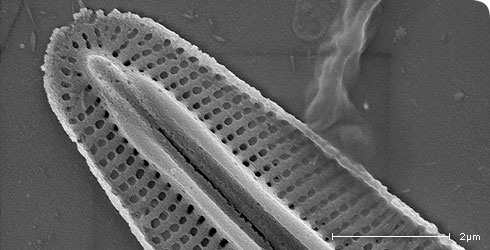Biology
Like many diatoms, Amphipleura cells are able to glide over surfaces, but they are easily brought into suspension, and their needle-like shape allows them to remain suspended in the plankton.
Diatoms have cell walls made of silica, constructed like pill- or date-boxes. They can be preserved in sediments over many centuries. The structure of the walls can be seen after cells have been treated to remove the organic contents.
Species are usually identified based on the shape and patterns of the silica walls. Amphipleura is distinguished by having two short slits, one at each end of the valve (half wall), flanked by ribs, with a long central connecting rib.
The fineness and regularity of the pores over the valves require very good light microscopes to be resolved.
Testing the resolution of microscope lenses
The rows of pores (striae) in A. pellucida are very fine and regular - 40-42 in 10µm, with pores that are about 0.2µm apart (about 50 in 10µm).
They were used to test the resolution of microscope lenses:
- a x100 objective with a x10 eyepiece and oblique light should resolve the striae
- a x100 objective with a x20 or x25 eyepiece with a green filter should resolve the pores within the striae
